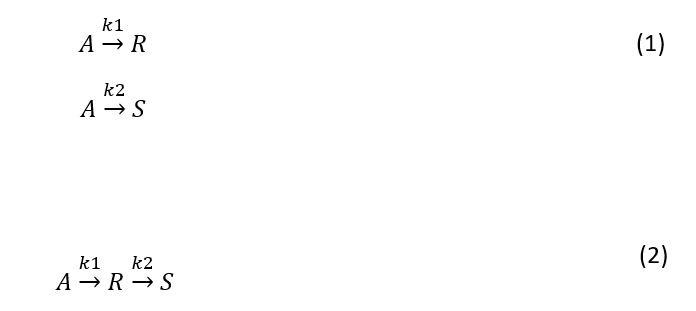If the initial concentration of A is 10 mol/L define the reaction rates of each species considering a batch reactor. For both reactions 1 and 2 obtain the dynamics of the concentrations of each species and discuss their behavior. a) Consider k1=k1=0.1 1 1/min and a time of 20 minutes. Explain the behavior of the concentrations for both reactions. b) Consider k1=0.2 and k2=0.3 1/min and a time of 20 minutes. Explain the behavior of the concentrations for both reactions. Justify your answer c) Consider k1=0.4 and k2=0.1 1/min and a time of 20 minutes. Explain the behavior of the concentrations for both reactions. Justify your answer. d) What happens if the concentration of A or the time of the process changes. Justify your answer.
If the initial concentration of A is 10 mol/L define the reaction rates of each species considering a batch reactor. For both reactions 1 and 2 obtain the dynamics of the concentrations of each species and discuss their behavior. a) Consider k1=k1=0.1 1 1/min and a time of 20 minutes. Explain the behavior of the concentrations for both reactions. b) Consider k1=0.2 and k2=0.3 1/min and a time of 20 minutes. Explain the behavior of the concentrations for both reactions. Justify your answer c) Consider k1=0.4 and k2=0.1 1/min and a time of 20 minutes. Explain the behavior of the concentrations for both reactions. Justify your answer. d) What happens if the concentration of A or the time of the process changes. Justify your answer.
Introduction to Chemical Engineering Thermodynamics
8th Edition
ISBN:9781259696527
Author:J.M. Smith Termodinamica en ingenieria quimica, Hendrick C Van Ness, Michael Abbott, Mark Swihart
Publisher:J.M. Smith Termodinamica en ingenieria quimica, Hendrick C Van Ness, Michael Abbott, Mark Swihart
Chapter1: Introduction
Section: Chapter Questions
Problem 1.1P
Related questions
Question
100%
Hi, I need help with this, it was an activity done in class but I couldn't solve anything.
From the following multiple reactions: (Reactions attached in the jpg file)
If the initial concentration of A is 10 mol/L define the reaction rates of each species considering a batch reactor. For both reactions 1 and 2 obtain the dynamics of the concentrations of each species and discuss their behavior.
- a) Consider k1=k1=0.1 1 1/min and a time of 20 minutes. Explain the behavior of the concentrations for both reactions.
- b) Consider k1=0.2 and k2=0.3 1/min and a time of 20 minutes. Explain the behavior of the concentrations for both reactions. Justify your answer
- c) Consider k1=0.4 and k2=0.1 1/min and a time of 20 minutes. Explain the behavior of the concentrations for both reactions. Justify your answer.
- d) What happens if the concentration of A or the time of the process changes. Justify your answer.

Transcribed Image Text:k1
A → R
k2
A → S
k1 k2
A R S
(1)
(2)
Expert Solution
This question has been solved!
Explore an expertly crafted, step-by-step solution for a thorough understanding of key concepts.
Step by step
Solved in 8 steps with 12 images

Recommended textbooks for you

Introduction to Chemical Engineering Thermodynami…
Chemical Engineering
ISBN:
9781259696527
Author:
J.M. Smith Termodinamica en ingenieria quimica, Hendrick C Van Ness, Michael Abbott, Mark Swihart
Publisher:
McGraw-Hill Education

Elementary Principles of Chemical Processes, Bind…
Chemical Engineering
ISBN:
9781118431221
Author:
Richard M. Felder, Ronald W. Rousseau, Lisa G. Bullard
Publisher:
WILEY

Elements of Chemical Reaction Engineering (5th Ed…
Chemical Engineering
ISBN:
9780133887518
Author:
H. Scott Fogler
Publisher:
Prentice Hall

Introduction to Chemical Engineering Thermodynami…
Chemical Engineering
ISBN:
9781259696527
Author:
J.M. Smith Termodinamica en ingenieria quimica, Hendrick C Van Ness, Michael Abbott, Mark Swihart
Publisher:
McGraw-Hill Education

Elementary Principles of Chemical Processes, Bind…
Chemical Engineering
ISBN:
9781118431221
Author:
Richard M. Felder, Ronald W. Rousseau, Lisa G. Bullard
Publisher:
WILEY

Elements of Chemical Reaction Engineering (5th Ed…
Chemical Engineering
ISBN:
9780133887518
Author:
H. Scott Fogler
Publisher:
Prentice Hall


Industrial Plastics: Theory and Applications
Chemical Engineering
ISBN:
9781285061238
Author:
Lokensgard, Erik
Publisher:
Delmar Cengage Learning

Unit Operations of Chemical Engineering
Chemical Engineering
ISBN:
9780072848236
Author:
Warren McCabe, Julian C. Smith, Peter Harriott
Publisher:
McGraw-Hill Companies, The